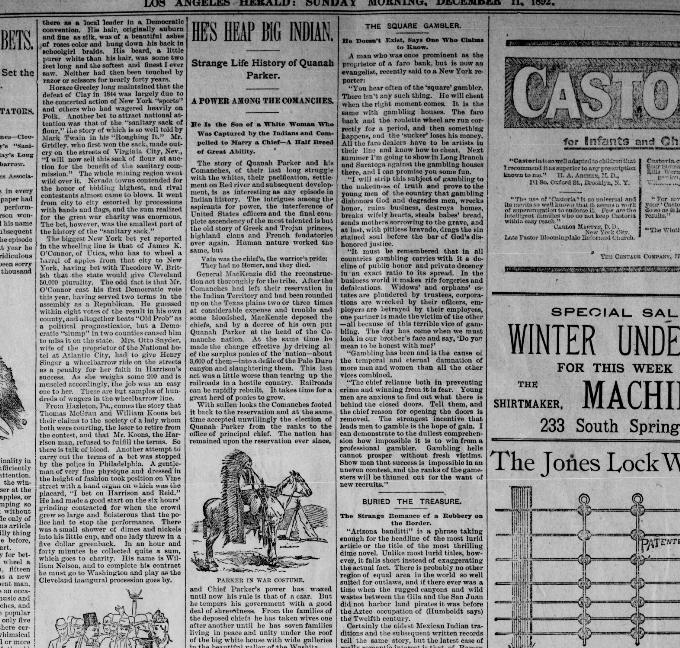|
Moderated by NW Okie! |
Volume 17 , Issue 202015Weekly eZine: (374 subscribers)Subscribe | Unsubscribe Using Desktop... |
Quanah Parker - He's Heap Big Indian

In the Los Angels Herald, dated Sunday, December 11, 1892, page 10, we find the "Strange Life History of Quanah Parker." A power among the comanches, Quanah Parker was the son of a white woman who was captured by the Indians and compelled to marry a chief. Quanah was a half breed of great ability.
As the 1892 newspaper reported: "The story of Quanah Parker and his comanches of their last long struggle with the whites, their pacification, settlement on Red River and subsequent development, is as interesting as any episode in Indian history.
The intrigues among the aspirants for power, the interference of United States officers and the final complete ascendency of the most talented is but the old story of Greek and Trojan prices, highland clans and French feudatories over again. Human nature worked the same, but ...
- "Vain was the chief's, the warrior's pride;
They had no Homer, and they died."
"With sullen looks the Comanches footed it back to the reservation and at the same time accepted unwillingly the election of Quanah Parker from the ranks tot he office of principal chief. The nation has remained upon the reservation ever since, and Chief Parker's power has waxed until now his rule is that of a czar. But he tempers his government with a good deal of shrewdness. From the families of the deposed chiefs he has taken wives one after another until he has seven families living in peace and unity under the roof of the big white house with wide galleries in the beautiful valley of the Washita.
"His first journey among the whites came perilously near to being his last. he and his co-chief, yellow Bear, one of his seven fathers-in-law, went to Fort Worth, Texas, took a room together, and, like another western dignitary of our own race, blowout the gas. When the door was broken open Yellow Bear was dead, and it took several dollars' worth of brandy and electricity to put Quanah on his feet again. He was worth all it cost and a great deal more, for he has made the Comanches one of the most tractable tribes in the Indian Territory; has secured for them the best land in the Red River valley; has induced them and their allies, the Kiowas, to take land in severalty, 100 acres apiece, and sold the rest to the government at rates which give the tribe a permanent fund of $2,000,000.
"Such an Indian naturally excites a deal of curiosity, and on inquiry it transpires that he is only half Comanche. His mother was a white woman, and her story and that of her family are among the saddest of border tragedies. Sixty years ago (1832) Elder John Parker, of Coles county, Illinois, an experienced pioneer, led a small party to the region that is now Limestone county, Texas, and built a blockhouse which was the beginning of Fort Parker. The rest is the old tale, a sudden attack in what was thought to be a time of peace and safety, the slaughter of all the men and captivity of the women and children, with all the sickening details of murder of infants which Americans have heard of since Hannah Dustin, of Haverhill.
"In three years all the captives were recovered by negotiation with other Indians except Cynthia Ann Parker, aged nine when taken, and her little brother John. The latter lived an Indian in all save color for many years, then married a Mexican girl who had been taken captive and went to live with her relatives in Mexico. He returned to Texas on a visit just in time to get into the civil war, served through it as a Confederate soldier and then returned to his ranch beyond the Rio Grande. Twenty-five years had passed since the Fort Parker massacre, when Captain Sul Ross, since Governor Ross, surprised and defeated the Comanches on Pease River. Their chief, Petanocona, was killed, and his wife and child were captured. That wife ws Cynthia Parker, and that child was a younger sister of Quanah Parker.
"For a year or two Cynthia had to be restrained to prevent her escape to her wild friends, but in time she became reconciled to civilization. Ten years later she died, and her daughter is a good Christian white woman in all save the half Indian blood. Her two sons grew up Comanches, and now the strange vicissitudes of Indian life have mad Quanah a white man in habits when among the whites, but still a Comanche when at home."
| View or Add Comments (0 Comments) | Receive updates ( subscribers) | Unsubscribe
| © . Linda Mcgill Wagner - began © 1999 Contact Me | |
